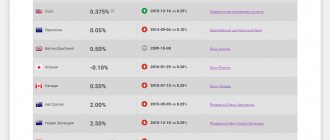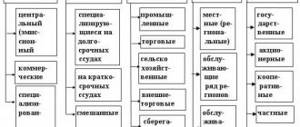07/12/2016 3 580 6 Reading time: 10 min. Rating:
Author
: Konstantin Bely
the European Central Bank (ECB) is : what is its structure, goals and functions, how it works, who runs it, what monetary policy it pursues, etc. There are many interesting facts and useful information that will be useful to everyone, at least for general development, further in the article.
Story
After the end of World War II, the unification of Europe began. Structuring was activated and the formation of a single market space began. In the period from 1947 to 1957, the period of integration of the states of the region was successfully completed with the parallel emergence of the European Payments Union. In 1957, the largest European states united into the European Economic Community. In 1979, fiat money - ECU - was introduced into the EEC for settlements that were immediately linked to a basket of European currencies. The memorandum on the formation of the European Monetary Area and the ECB was signed in 1988. LLC CB "Central European Bank" appeared after the signing of the international treaty on the creation of the EU in 1992 in Maachtricht, as well as after the formation of the European Monetary Institute, whose responsibilities included preparing for the transition to a single currency - the euro.
External and internal structures
The European Central Bank has a unique leadership team. It includes representatives from each EU member state. Issues related to the work of a financial institution, discount rates, bills and other issues are discussed by the management of the institution and the board of governors. The directorate consists of 6 people, including the chairman of the bank and his deputy. The governing body is elected for an eight-year term. Candidates for a position in the directorate are nominated and considered by the European Parliament and the heads of states that are part of the European zone. The ECB is a member of the European System of Central Banks, which includes the national central banks of the European Union countries. The international system operates according to a two-level algorithm. Any issue regarding monetary policy can only be resolved if agreement is reached at each level.
Organization
The decision-making process in the Eurosystem is centralized through the governing bodies of the ECB, namely the Governing Council and the Executive Board. As long as there are EU member states that have not adopted the euro, there will also be a third governing body - the General Council. NPOs of member states that do not participate in the euro area are members of the ESCB with a special status – although they are allowed to implement their respective national monetary policies, they do not take part in decisions regarding the single monetary policy for the euro area and implementation such decisions.
The Board of Governors includes all members of the Executive Board and governors of the national central banks (NCBs) of the member states without exception, i.e. those countries that have adopted the euro. Main responsibilities of the Governing Council:
- Adopt the guidelines and take the decisions necessary to ensure the fulfillment of the tasks entrusted to the Eurosystem.
- Formulate euro area monetary policy, including, where necessary, decisions regarding interim monetary objectives, key interest rates and the supply of reserves in the Eurosystem.
- Establish necessary guidelines for their implementation
The Executive Council consists of a President, a Vice President and four other members selected from among persons of recognized authority and professional experience in monetary or banking matters. They are appointed by general consent of the governments of the member states at the level of heads of state or government, on the recommendation of the Council of Ministers after consultation with the European Parliament and the Governing Council of the ECB (i.e. the Council of the European Monetary Institute (EMI) for first appointments). Main responsibilities of the Board:
- Implement monetary policy in accordance with the guidelines and decisions established by the Governing Council of the ECB, while providing the necessary instructions to NPOs.
- Exercise the powers delegated to it by the Governing Council of the ECB.
The General Council consists of the president, vice-president and governing NGOs of all 27 member states. The General Council carries out the tasks that the ECB took over from the EMI and which, due to the defection of one or more Member States, still have to be carried out in the third stage of the Economic and Monetary Union (EMU). The General Council also promotes:
- Advisory functions of the ECB
- Collection of statistical information
- Preparation of ECB annual reports
- Establishing the necessary rules to standardize accounting and reporting on transactions carried out by non-profit organizations.
- Taking measures related to the establishment of a key for subscription to the capital of the ECB, in addition to those already specified in the Treaty
- Setting conditions for the employment of ECB staff
- Necessary preparations for the irrevocable fixation of exchange rates of the currencies of member countries with a deviation from the euro
The ESCB Statute provides for the following measures to ensure security of tenure for NPO managers and members of the Executive Board:
- The minimum renewable term of office for governors of national central banks is five years.
- The minimum non-renewable term of office for members of the Executive Board is eight years (a system of staggered appointments for non-President members was used to ensure continuity at the first meeting of the Executive Board)
- Removal from office is possible only in cases of incapacity or serious misconduct; in this regard, the Court of Justice of the European Union is competent to resolve any disputes.
General information
Since its creation in Germany, in Frankfurt, the Central European Bank has united under its leadership the entire system of European central banks. The structure includes:
- Bank of Belgium.
- Bundensbank.
- Bank of Greece.
- Bank of Spain.
- Bank of France.
- Monetary Institute of Luxembourg.
Only the ECB has the status of a legal entity; all other financial institutions included in the system play the role of auxiliary units. Their tasks are secondary. The main goal of the ECB is to prevent sharp increases in prices and stabilize the inflation rate, which should not exceed 2%. Any decisions and actions of the bank have a direct impact on the exchange rate of the European currency against other currencies of the world. Sharp fluctuations are caused by changes in interest rates and the provision of credit to member states of the union.
GLOBFIN.RU
To the extent that it does not damage the main purpose of its existence - maintaining price stability, the European System of Central Banks is called upon to support the general economic policy within the European Economic and Monetary Union.
The ESCB is an independent banking system. In carrying out their activities, members of its management bodies do not have the right to use instructions or regulations of governments and public authorities of the countries of the European Economic Community or external countries. In turn, the institutions of the European Economic Community and the governments of the EMU member states do not have the right to interfere in the activities of the European System of Central Banks.
The Statute of the ESCB presents the following measures that determine the security of the policies pursued and the independence of the governors of the National Central Banks from external influence:
- the minimum term of office as a manager of the national securities market is five years;
The minimum (non-renewable) term of office for members of the ECB Executive Directorate is eight years. At the same time, the procedure for approving the President and Vice-President for the first Executive Directorate is different from the procedure for approving its other members;
The responsibility of the European System of Central Banks and the rules of dialogue between the ESCB and the European international institutions also meet the requirements of independence.
Members of the Executive Directorate are appointed by mutual agreement by the heads of state or government of the EMEA member countries, taking into account the recommendations of the Council of the European Union. Approval by the European Parliament is a necessary condition for the appointment of members of the Executive Directorate.
The Chairman of ECOFIN and members of the Commission of the European Council can take part in meetings of the Executive Directorate without the right of a deciding head, while the Chairman of ECOFIN can submit proposals for consideration by the Board of Governors.
The ECB must submit its annual report to the bodies of the European Community, to the European Parliament, and members of its Executive Directorate are required to appear when summoned before the competent Committees of the European Parliament. Quarterly reports on the activities of the ESCB serve as the basis for quarterly negotiations with the European Parliament in the presence of the President of the ECB or, if necessary, members of the Executive Directorate.
Two representatives of the ECB and representatives of the NCBs are members of the Economic and Financial Committee, which brings together representatives of the ministers of economy and finance and the central banks of the EEC member countries and prepares the ECOFIN meeting.
The President of the ECB or other members of the Executive Directorate may be heard by the European Parliament on its own initiative or at the request of Parliament. In addition, national laws generally provide that the heads of NCBs will also be heard by national parliaments. The Court of Justice of the European Community has powers to review acts or omissions of the ECB.
The activities of the ECB include:
- providing loans, including pawn loans, to financial institutions;
- open market operations with various financial instruments;
- establishing minimum reserve requirements for credit institutions of the EEMS member countries.
A characteristic feature of the ECB’s activities is that all fundamental decisions taken by a simple or qualified (2/3 votes) majority provide for a “weighted” vote of the heads of central banks, in which the “weight” (i.e. the number of votes of each of them) determined in accordance with the share of the relevant country (its central bank) in the total capital of the ECB. This does not apply to members of the Executive Directorate, each of whom has only one vote.
The ECB can engage in the usual operations of central banks: providing loans, including pawn loans (secured by securities), to financial institutions and open market operations with various financial instruments denominated in any currency, including in the currencies of countries outside the ECB. EEBC, as well as with precious metals. The same operations can be carried out by National Central Banks, guided by the general principles developed by the ECB.
The ECB's Statute provides for significant decentralization of the activities of the European System of Central Banks, so that operations such as repos and foreign exchange interventions are independently carried out by the National Central Banks. Each of them can also independently determine which commercial bank assets are acceptable as collateral.
The European Central Bank and National Central Banks do not have the right to lend (in any form) to interstate (in the EEC system), state, regional and local authorities and organizations operating on the basis of state law. This, however, does not apply to state credit institutions, which in this case are treated in the same way as private credit institutions.
The ECB and NCBs can establish links with central banks and financial institutions of other countries and international organizations and carry out all types of banking activities with them, using any financial assets and currencies.
The equity capital of the ECB at the beginning of its activities was determined in the amount of 5 billion ECU (i.e. 5 billion euros starting from January 1, 1999). in the future, by decision of the Board of Governors, it may increase. Only National Central Banks can be shareholders of the ECB. The ECB's capital is formed in proportion to the comparative demographic and economic weight of the national central banks. The key indicator is the average weighted share of each country in the population and GDP of the “euro area”, which is determined by the following formula:
- 50% of this share - in accordance with the share of each country in the total population of the European Economic Community;
- 50% - in accordance with its share in the total gross domestic product of the EEC.
These data will be adjusted every 5 years.
According to the constituent documents, the net profit of the ECB should be distributed in the following order:
- part of it, which is determined by the Board of Governors (but not more than 20% of all net profit), is transferred to the general reserve fund (the volume of which should not exceed 100% of the authorized capital);
- the remaining part is distributed among the bank's shareholders in the appropriate proportion.
Monetary policy instruments and ESCB operations
The Statute of the ESCB (Articles 17 to 24) defines monetary policy instruments and operations, the implementation of which will allow the system to solve the tasks assigned to it. The main instruments of the ESCB's monetary policy are: conducting open market operations, regulating the discount rate through deposit and loan transactions and establishing minimum reserve requirements for credit institutions.
The main object of regulation during these operations is the liquidity of credit institutions, which directly affects the demand and supply of money in the economy, thereby significantly affecting the rate of inflation.
The conditions for conducting these operations, which are the same for all countries participating in the euro area, provide information to money market participants about the main directions of the monetary policy of the European Economic and Monetary Union and ensure its unity.
Credit institutions that meet the following qualification requirements are allowed to operate in the UEMS: stability, effective management, and broad operational capabilities. The list of credit institutions that must meet minimum reserve requirements includes more than 8 thousand credit institutions in the Eurozone, more than 4 thousand of them have access to deposit and loan operations, and about 3 thousand participate in refinancing operations.
Open market operations play an important role in the monetary policy of the ESCB in order to influence the interest rate, manage the overall liquidity of the money market and anticipate possible difficulties in the conduct of monetary policy. To conduct open market operations, the ESCB has four financial instruments at its disposal. The most important of these are refinancing transactions applied on the basis of appropriate agreements for the resale of loans or mortgaged loans. The ESCB may also issue debt certificates, carry out foreign exchange operations and attract deposits for a limited period. It is also possible to carry out operations on the basis of standard tenders, urgent tenders or bilateral procedures.
Depending on the purpose, repetition and steps taken, open market operations carried out by the ESCB can be divided into four main categories:
1. Major refinancing operations play a central role in regulating interest rates, managing the amount of liquidity in the market and clarifying the rationale for the ECB's monetary policy. It is these transactions that provide the bulk of private sector refinancing.
The distinctive features of the main refinancing operations are as follows:
- “work” only in one direction, towards the transfer of additional liquid funds to the private sector;
- are held regularly, every week;
- usually have a maturity of two weeks;
- operations are carried out decentralized through National Central Banks;
- access to them is provided on the basis of standard tenders;
- all counterparties that meet the general criteria for participation in tenders can submit applications for participation in them;
- Assets of both the first and second categories are accepted as collateral.
2. Long-term refinancing operations are designed to provide the required level of refinancing of long-term operations. They do not serve as a means of adjusting interest rates and are provided on the basis of current market rates, so tenders are usually conducted on the basis of variable interest rates. Only in exceptional circumstances may the ESCB carry out tenders on the basis of fixed interest rates. By using these operations, the ESCB does not intend to exert any pressure on the money market, and will act as a normal recipient of loan interest. The scope of these operations is limited and relatively small.
Distinctive features of long-term refinancing operations:
- serve as a means of providing liquidity;
- are held regularly, every month;
- usually have a maturity of three months;
- carried out in a decentralized manner, through National Central Banks;
- are carried out on the basis of standard tenders;
- all counterparties that meet the general criteria for participation in tenders can submit applications to participate in them;
- In principle, assets of both the first and second categories can be accepted as collateral. However, with the consent of the Governing Council of the ECB, National Central Banks have the right to impose certain restrictions regarding both the size and composition of the collateral.
3. Reverse “fine-tuning” transactions are carried out using a reverse transaction instrument (by conducting additional reverse transactions, selling and purchasing assets under simple forward transactions), in addition, the ESCB can accept deposits and conduct currency swap transactions. The purpose of these operations is to influence the liquidity position in the market and interest rates, in particular to smooth out the impact of unexpected changes in the amount of liquidity in the market on interest rates. The potential importance of rapid action determines the ESCB's desire to maintain a high degree of flexibility in the choice of procedures and specific forms of this type of operation.
Reverse “fine tuning” operations have the following features:
- can be used both for the provision and withdrawal of liquid funds;
- can be either regular or irregular;
- have a priori repayment period that is not regulated;
- operations aimed at providing liquidity are usually carried out on the basis of quick tenders, although the possibility of using bilateral procedures is not excluded;
- operations aimed at absorbing liquidity are usually carried out through bilateral procedures;
- usually carried out in a decentralized manner, through National Central Banks (in exceptional circumstances, the Governing Council of the ECB may decide to conduct bilateral exchange operations directly by the ECB);
- The ESCB may select a limited number of counterparties to carry out this type of operation;
- Assets of both the first and second categories are accepted as collateral.
4. Structural reverse transactions are the prerogative of the ESCB and are carried out through the issue of debt certificates, reverse transactions, purchase and sale of assets on simple forward terms. These operations are carried out on the open market with the aim of adjusting the structural position of the ESCB in relation to the private sector.
They are characterized by the following points:
- carried out for the purpose of providing liquidity;
- carried out regularly or not regularly;
- have a repayment period that is not a priori regulated;
- are carried out on the basis of standard tenders;
- carried out in a decentralized manner, through National Central Banks;
- all counterparties that meet the general criteria can submit applications to participate in this type of transaction;
- Assets of both the first and second categories are accepted as collateral.
First class assets include marketable debt instruments that meet the general reliability criteria established by the ECB for the entire euro area. Second class assets are marketable and non-marketable debt instruments, securities and non-marketable financial instruments, the reliability criteria of which are established by National Central Banks in accordance with the requirements of the ECB.
From the point of view of reliability in conducting monetary policy, there are no differences between instruments of both classes (except that assets of the second class are not used by the EMU in simple forward transactions). The bulk of the assets (75%) used in EEAS operations are represented by government securities; securities issued by credit institutions account for 18%, by the corporate sector – 4%; the remaining 3% is issued by national central banks.
The rate for the first main refinancing transaction was set at 3%. Currently (since October 11, 2000) this value is 4.75%.
The deposit and lending operations of the ESCB also have specific features, which play an important role in regulating the liquidity of banking institutions. The ESCB offers two permanent types of operations:
- “additional credit operations” allowing credit institutions to attract a maximum overnight CS loan in order to achieve the required level of daily liquidity against collateral of their own assets with a predetermined interest rate (the interest rate in this case will be the maximum possible for the given overnight loan market);
- “deposit operations”, which enable banking institutions to place overnight deposits on securities accounts with interest accrued at a predetermined interest rate (it should be noted that they will be able to earn little money from this - the interest rate will drop to the minimum possible for the given market).
These operations should be considered in conjunction, as a single system through which credit institutions can replenish their liquidity or, conversely, reduce it in the short term on an overnight basis.
Deposit and lending operations of the ECB are carried out at the initiative of banking institutions.
When carrying out anti-inflationary policy, the ESCB also relies on such an instrument as minimum reserve requirements for credit institutions. These requirements perform two interrelated functions: stabilizing money market interest rates and influencing the liquidity structure of the banking system. The mechanism of minimum reserve requirements leaves significant opportunities for regulating the liquid position of banks using market methods on a daily basis, allows for short-term arbitrage operations and maintaining the required level of profitability. This is achieved by the fact that the ESCB's reserve requirements for credit institutions must be met on the basis of a monthly average rather than a daily position. In this case, the corresponding month begins on the 24th calendar day of each month and ends on the 23rd day of the next month.
The system of minimum reserve requirements operating in the euro area countries is based on the following principles:
First, reserve requirements apply to all lending institutions.
Secondly, the reserve requirement for each specific credit institution is established by applying the reserve rate (currently 2%) to obligations in the forms of: 1) overnight deposits; 2) deposits with agreed maturities or redeemable upon notice with a period of up to two years; 3) similar in terms of maturity of debt securities; 4) money market securities.
Thirdly, when establishing the amount of reserve requirements, the following calculation procedure is provided. If a credit institution is unable to provide confirmation of the amount of obligations in the form of debt securities with a maturity of up to two years and money market securities, it is permitted to apply a standard calculation based on 10% of the amount of the above obligations. When calculating the final reserve requirement, each credit institution can make a deduction from the result obtained by law in the amount of 100 thousand euros. The required reserves held in the accounts of the ESCB are accrued interest at the average rate for main refinancing operations, i.e. in accordance with market conditions.
Fourthly, a credit institution has the right to apply to the National Central Bank of the ESCB member country for which it is a resident for permission to meet reserve requirements through an intermediary.
The implementation of a comprehensive anti-inflationary policy by the ESCB made it possible to ensure price stability during the transition to a single currency. From January to May 1999 In the euro area countries, the growth rate of prices for consumer goods was 1% on an annualized basis, while in the USA - 2.1%, in Canada - 1.5%, and on average for the group of industrial countries - 1.2%. A significant increase in the role of transactions with securities within the system, especially their active use as collateral, indicates that when conducting transactions, primary attention is paid to reliability. This creates a psychological climate of confidence in the money and financial markets, which objectively reduces inflation expectations in the economy.
What does the ECB do?
The Central European Bank simultaneously performs several dominant functions:
- Development and implementation of monetary policy in the euro area.
- Providing, developing and managing exchange reserves of countries from the euro area of an official nature.
- Euro issue.
- Setting interest rates.
- Ensuring price stability in the European zone.
The ECB's indicators are the consumer price index for consumers throughout the EU and the size of the money supply, the growth of which during the year should not exceed 4.5%.
Goals and objectives of the ESCB
Note 1
The main goal of the ESCB is to maintain price stability in the European Union.
The Statute of the ESCB stipulates that in order to maintain price stability, within the framework of the strategy of this organization, the key economic directions of the EU policy must be implemented. To ensure price stability, the ESCB promotes the emergence of financial conditions that promote economic growth and job creation.
Since all European states position themselves as a social state, each public institution is responsible, first of all, to citizens. European central banks operate according to the principle of an open economy with free market competition. This allows for more efficient allocation of resources.
European central banks implement the following tasks:
- determine and implement the monetary policy of the European Community;
- conduct international exchange operations;
- own and manage the official foreign currency reserves of all member states;
- contribute to the smooth functioning of the payment system.
Basic bank interest rates
The functions of the European Central Bank include determining and setting interest rates. Interest rates can be of three types:
- Refinancing rate. This is the interest rate that determines the minimum value for applications to raise funds in a tender held by the ECB.
- Deposit rate. This is the interest rate that is the base rate when placing free funds in ECB institutions. The rate acts as a lower bound in the overnight interest rate market.
- The marginal borrowing rate is the rate at which banks of the ESB structure can obtain a loan that is necessary to maintain short-term liquidity. The cap acts as the cap on the range within the overnight interest rate market.
By setting these types of rates, the European Central Bank creates the demand or supply of the currency, ensures its stability and controls cash flows within the zone.
Participating banks [edit]
The ESCB consists of the European Central Bank and the national central banks of all 27 member states of the European Union. The first section of the following list lists the member states and their central banks that make up the Eurosystem (plus the ECB), which set monetary policy for the eurozone. The second section lists the member states and their central banks that support the different currencies.
| State | central bank | Governor [2] | Web site |
| Members of the Eurozone (Eurosystem) | |||
| Eurozone | European Central Bank | Christine Lagarde | [1] |
| Austria | Oesterreichische Nationalbank | Robert Holtzmann | [2] |
| Belgium | National Bank of Belgium | Pierre Wunsch | [3] |
| Cyprus | Central Bank of Cyprus | Crystal Jorkatsi | [4] |
| Estonia | Bank of Estonia | Ardo Hansson | [5] |
| Finland | Suomen Pankki | Erkki Liikanen | [6] |
| France | Banque de France | Francois Villeroy de Gallo | [7] |
| Germany | Deutsche Bundesbank | Jens Weidmann | [8] |
| Greece | Trapeza tis Ellados | Yiannis Stournaras | [9] |
| Ireland | Central Bank of Ireland | Gabriel Makhlouf | [10] |
| Italy | Bank of Italy | Ignazio Visco | [11] |
| Latvia | Latvijas Banka | Ilmars Rimsevics | [12] |
| Lithuania | Lietuvos Bankas | Vitas Vasiliauskas | [13] |
| Luxembourg | Central Bank of Luxembourg | Gaston Reineche | [14] |
| Malta | Central Bank of Malta | Joseph Bonnici | [15] |
| Netherlands | De Nederlandsche Bank | Klaas knot | [16] |
| Portugal | Banco de Portugal | Mario Centeno | [17] |
| Slovakia | Národná banka Slovenska | Peter Kazimir | [18] |
| Slovenia | Banka Slovenije | Boštjan Yazbek | [19] |
| Spain | Banco de España | Pablo Hernandez de Cos | [20] |
| Outside the Eurozone (outside the Eurosystem) | |||
| Bulgaria | Bulgarian National Bank | Dimitar Radev | [21] |
| Croatia | Croatian National Bank | Boris Vujicic | [22] |
| Czech | Czech National Bank | Jiri Rusnok | [23] |
| Denmark | National Bank of Denmark | Lars Rohde | [24] |
| Hungary | Magyar Nemzeti Bank | Gyorgy Matolcsy | [25] |
| Poland | Narodowy Bank Polski | Adam Glapinski | [26] |
| Romania | National Bank of Romania | Mugur Constantin Isarescu | [27] |
| Sweden | Sveriges Riksbank | Stefan Ingves | [28] |
General provisions
The European Central Bank is a unique legal entity whose work is based on international agreements. The authorized capital of the institution at the time of its creation was equal to 5 billion euros. The largest banks in Europe acted as shareholders. The German Bundesbank contributed 18.9% of the capital, the Bank of France - 14.2%, the Bank of Italy - 12.5%, the Bank of Spain - 8.3%. The remaining central banks of European states contributed from 0.1% to 3.9% of the initial authorized capital. The activities of the financial institution are managed by the executive board mentioned above, headed by the Chairman of the European Central Bank. The main feature of a financial organization is complete independence. At the same time, the institute is obliged to submit a report on its activities every year to the European Parliament, the European Commission, the Council of the European Union and the Council of Europe.
Activity Policy
To achieve its objectives, the ECB uses instruments such as stabilization loans and collateral auctions, foreign exchange transactions and open market transactions. The most powerful instrument for regulating the financial market is the rate of the European Central Bank. The work of the monetary institution is based on the principles of independence from other states, as well as from supranational regulatory bodies. The work of the latter, first of all, provides for the absence of coercion when covering external and internal debt. To make a decision on each specific resolution, a majority of members of the management council must vote for it. Each of them has only one opportunity to vote. The head of the European Central Bank must follow the advice of the council. Only after a certain decision has been made can the central banks of European countries be actively involved in its implementation.
Functions of the ECB
Let's look at the key functions of the ECB .
- Euro issue. This is the main function of the European Central Bank, for which it was primarily created. The euro is the official currency of 19 countries that are members of the eurozone, as well as another 9 countries that are not members of the EU, of which 7 are located on the European continent. All decisions on the issue of the euro are made exclusively by the ECB, but the issue itself can only then be carried out by the Central Banks of the countries of the Euro zone.
- Conducting monetary policy in the eurozone. The European Central Bank has at its disposal all the key instruments for regulating financial markets: discount rate, reserve ratio, securities transactions, etc. All monetary policy affecting eurozone countries is within the competence of the ECB.
- Management of gold and foreign exchange reserves of the European Union. The European Central Bank concentrates the EU's gold and foreign exchange reserves, and it makes decisions about their spending or replenishment.
- Maintaining an acceptable level of inflation in the eurozone. This function of the ECB is also considered key. The European Central Bank is responsible for ensuring that consumer price growth in the eurozone does not exceed 2%, but at the same time deflation is not allowed.
Powers of the ECB and national central banks
The ECB, in joint efforts with the central banks of the member states of the association, has the right to form relations with the central banks of other states, and, if necessary, with international organizations. Opportunities are open for the acquisition, sale and forward of any type of assets, including banking metals. The concept of “currency assets” includes securities in any currency and in any units of account. Ownership and management of assets is allowed. The ECB conducts a wide range of banking organizations of any type, in which international organizations and representatives of third parties may act as partners. Partnership relationships may include borrowing and credit operations. In addition to the main functions mentioned above, the European Bank, in cooperation with the Central Banks of European countries, can carry out operations with administrative purposes, as well as act in the interests of board members. An important stage in the development of the bank’s activities can be called the formation of the European Monetary System, which began to exist in 1979.
European Monetary System within the ECB
The European Central Bank refinancing rate is not the only thing that affects the European Monetary System. EMU itself has a number of specific tasks. We can talk about the following areas:
- Ensuring currency stability within the EU.
- Maximum simplification of convergence processes with active economic development.
- In conditions of stability, the currency system provides a growth strategy.
- Stable systematization of monetary and economic relations of an international nature.
It was thanks to the introduction of such a monetary unit as the ECU into circulation that the states of the European Union successfully coped with the crisis of the 80s. After the victory over the inflation process, restrictions on current financial transactions were lifted. Since 1990, the free flow of capital regime has been activated. Initially, the EU's goal was to ensure optimal conditions for the movement of goods and services, capital and labor. The ECB was created to stimulate the introduction of a common currency and common citizenship. His work, even at the planning stage, was supposed to help form organizational and legal mechanisms for coordinating not only the foreign policy, but also the security policy of each participating state.
Current state of the EU banking system
The crisis of 2008-2010 exposed many problems existing in the financial sector of the European Union. So the most noticeable of them was the budget deficit. Some EU member states have mismanaged their finances, and existing regulations have not been enough to curb their profligacy. This was especially evident in the Greek crisis of 2010. The banks that held Greek debt could become insolvent and drag the entire economy down with them. After this, following the example of the United States, the European Union conducted a series of stress tests covering 91 of the largest banks. According to a joint statement by the EC and the ECB, the test results demonstrate the overall resilience of the banking system to adverse macroeconomic and financial shocks, and are an important step forward in restoring confidence in the market. Earlier it became known that 7 banks out of 91 failed this test. According to the ECB's recommendations, they should first try to strengthen their capital base through the private sector, and, if necessary, resort to government assistance, while complying with EU rules regarding state aid mechanisms.
Thus, we can conclude that the EU banking system is a very stable financial and credit institution in Europe, ensuring the stable development of the region.










